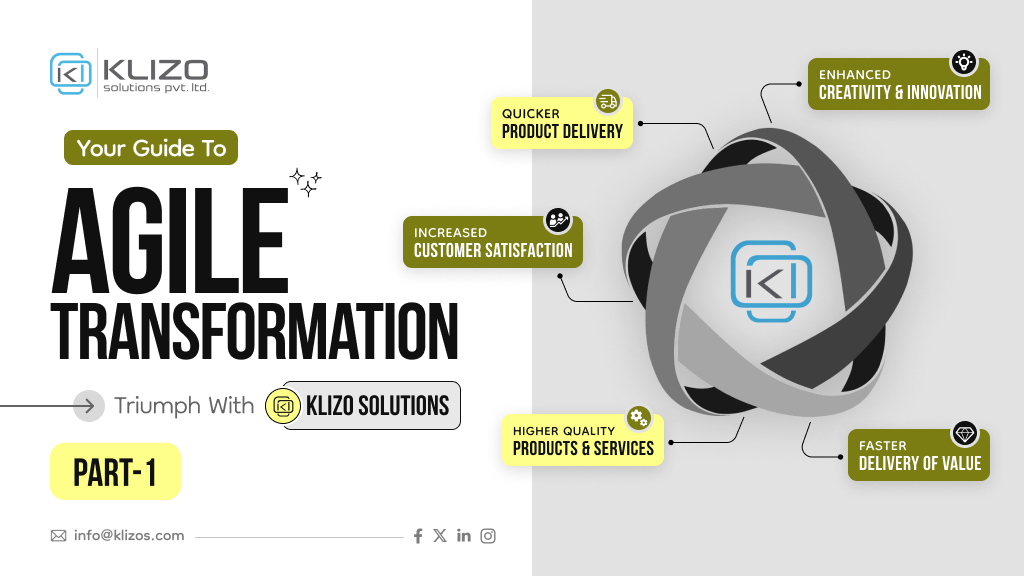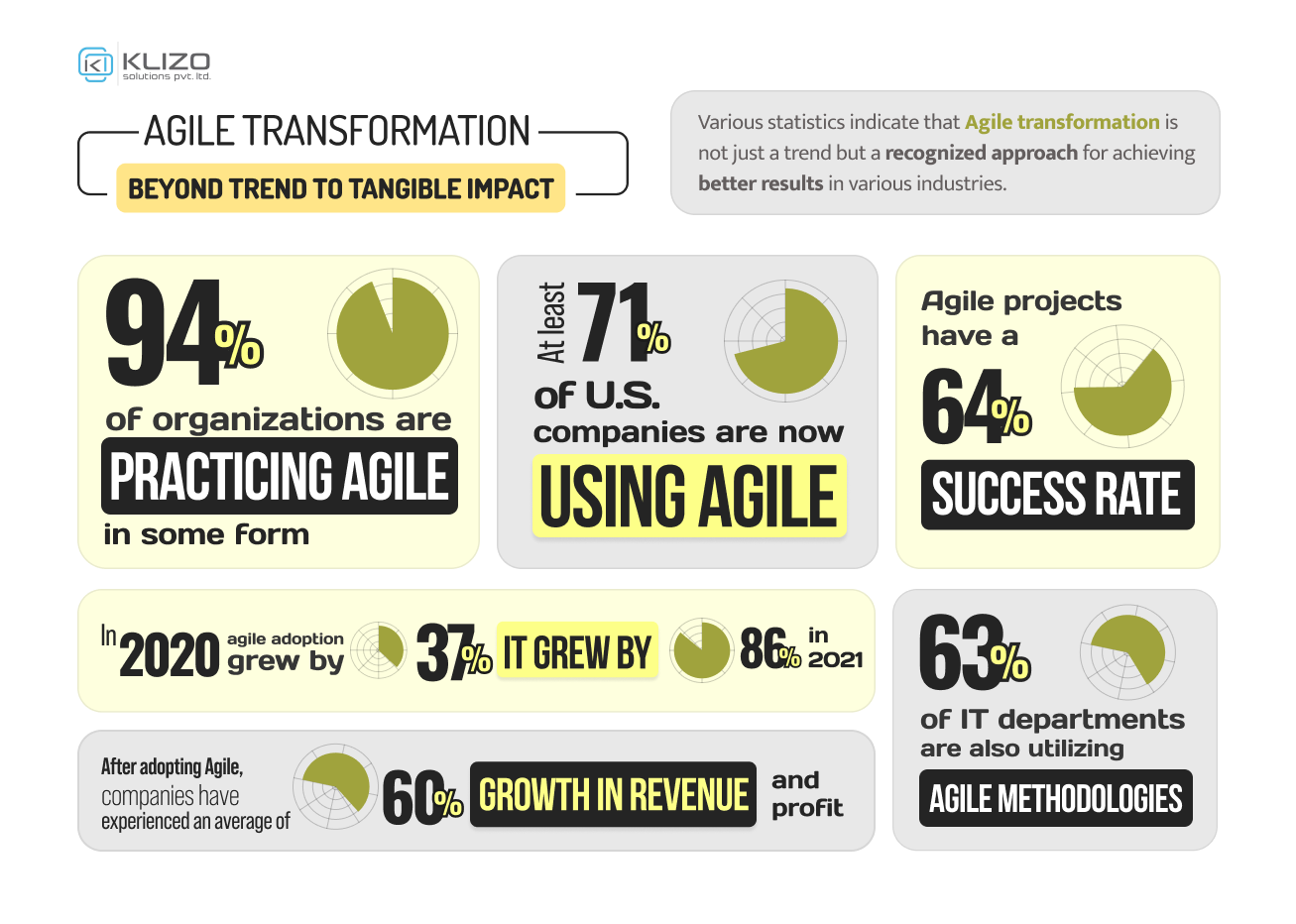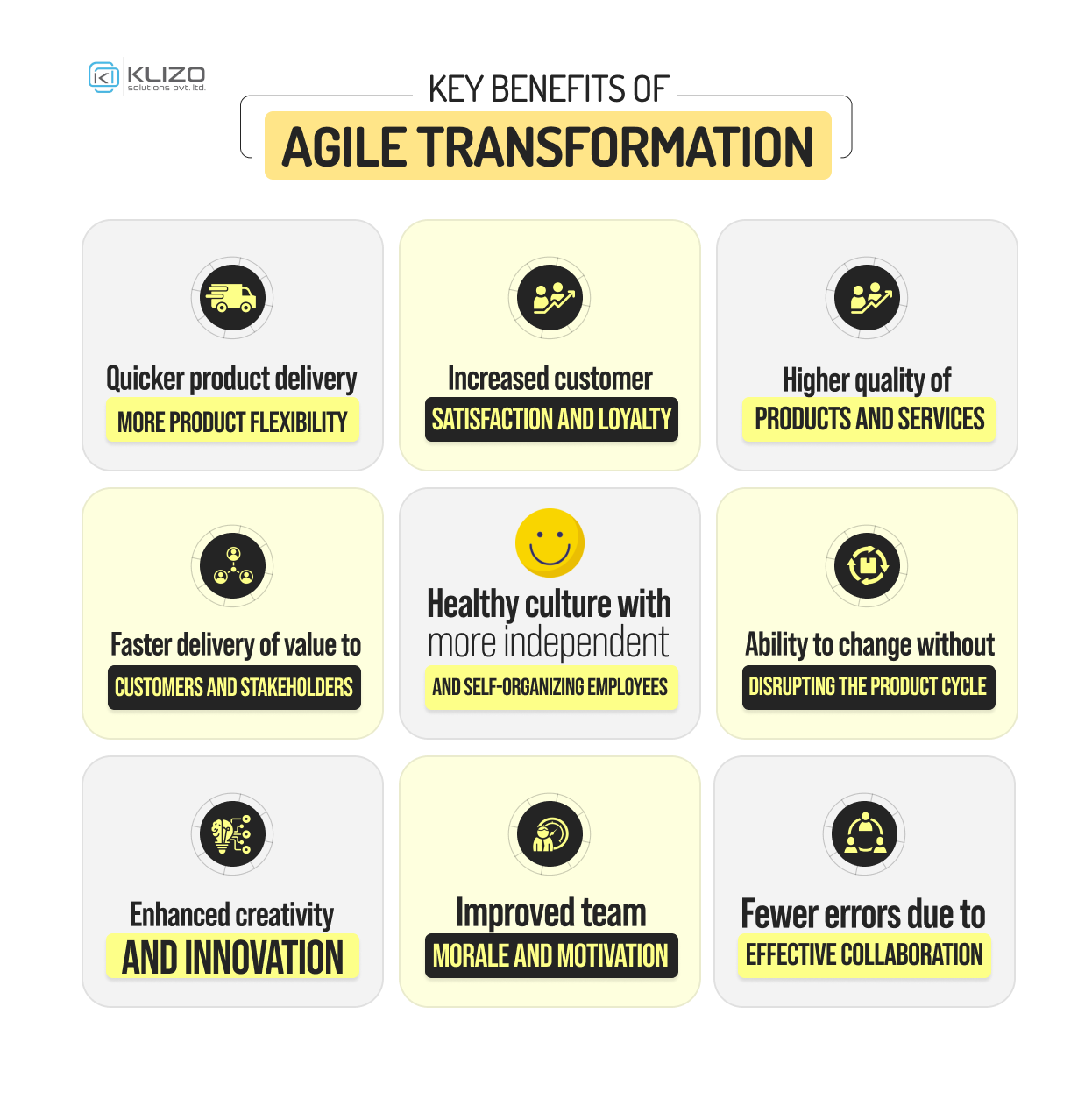


The business landscape resembles a whirlwind of change, with new technologies and market demands swirling like a tornado.
In this fast-paced environment, adaptation isn’t just an advantage; it’s an absolute necessity.
And this brings us to Agile Transformation – a complex yet effective medium helping businesses evolve to thrive in the chaos.
In professional software development, agility isn’t merely a buzzword—it’s the secret sauce to streamlining processes, accelerating value delivery, and elevating the customer experience.
As a professional software development company, we, Klizo Solutions, are proud to admit that we have achieved this agile excellence over the years!
But for those of you who still do not know what is agile transformation or why it matters to choose an agile development company when looking to outsource your software development projects, this article is what you need!
So, fasten your seatbelt as we embark on a two-part odyssey to demystify Agile Transformation and embark on a transformative journey like no other!
Agile transformation refers to adapting agile principles and methodologies to change an organization’s culture, structure, and practices to ensure customer focus, collaboration, flexibility, and quality.

Agile definition stands as a flexible and adaptive way of delivering value to customers through iterative and collaborative work cycles. So, once you understand the agile meaning, you can surely know what it means for an organization.

Remember, Agile transformations are not just about adopting agile methodology or frameworks for the product development team but reshaping the organization as a whole.
It’s a complex process that requires a step-by-step transition to create a mindset and environment that supports agility across the entire organization. It emphasizes flexibility, collaboration, and iterative progress to adapt to evolving needs.
Imagine a software development project in a traditional approach, where the entire project plan is established upfront, processes are rigid, there are chances of delays, and any changes can be costly.
Now, the same project in Agile allows for continuous feedback, enabling developers to adjust requirements, fix issues, and deliver a better agile product as they go along.
Agile transformation is commonly associated with SaaS development organizations and SaaS development teams. But in reality, enterprise agile transformation can benefit organizations of all kinds.
Agile is the ultimate way for any organization that wants to be flexible, collaborative, and transparent. These qualities that agile transformation bestows are beneficial for everyone, regardless of whether they offer a SaaS product or not.
Going agile usually means adopting agile practices such as time-boxed sprints, self-organizing teams, etc. And yes, these practices impact the way you get the work done. But sadly, it cannot change the organization fundamentally or make a failing company or product successful.
Going agile in its complete sense is more than how the work gets done. To ensure a true organization-wide agile transformation, you need to assess a lot of things, such as:
Plus, for an organization to undergo complete agile transformation, it must implement changes in the three key areas, which are:
And even this is not it. To completely embrace agile transformation, an organization must improve its CPE or Complete Product experience, from customers purchasing the product to becoming loyal to the company.
Flexibility: Agile encourages teams to be adaptive and open to change throughout a project’s lifecycle.
Instead of rigidly sticking to a fixed plan, teams regularly assess and adjust their strategies.
Collaboration: Agile methodology promotes close collaboration of team members and stakeholders.
This collaborative spirit is nurtured through daily stand-up meetings, frequent feedback sessions, and shared responsibilities, which work together to cultivate teamwork and ensure everyone is aligned.
Iterative Progress: Projects are divided into smaller, manageable components called “sprints” or “iterations.”
After each cycle, teams reassess their progress and make necessary improvements.
This dynamic approach to project management and organizational change aims to deliver value faster and better to customers while boosting innovation, efficiency, and employee engagement.

Agile transformation offers several key benefits to a business or organization involved in software development. These advantages contribute to improved productivity, higher customer satisfaction, increased adaptability to changing market conditions, and more.
Here are some of its key benefits:
1. Improved Efficiency, Reduced Obstacles
Agile practices like daily stand-up meetings and retrospectives foster improved collaboration between teams. Teams no longer stay isolated in their tasks. It makes team members more engaged, motivated, and accountable for what they do.
Yes, enterprise agile transformation lets teams share their skills and knowledge to craft agile products and helps them work more efficiently. For example, cross-functional teams work together closely, leading to better decision-making.
2. Stronger Communication
Improved collaboration happens only when the communication between teams becomes better. Agile transformation emphasizes exchanging ideas, delivering feedback, and testing to ensure clear and open communication.
For example, teams use tools like Slack and Zoom to stay connected efficiently and interact quickly and easily.
3. Improved Quality
Agile transformation enhances product quality by integrating testing and feedback throughout development, emphasizing customer satisfaction, fostering collaboration, promoting continuous improvement, and addressing technical debt.
While frequent testing and validation during development reduce the likelihood of major defects, continuous integration, and continuous delivery (CI/CD) pipelines ensure a higher level of software quality.
4. Faster Time-to-Market
While agile principles help teams complete software development projects faster, agile transformation lets teams work more independently without having to be micromanaged at every step.
For example, products or features can be released sooner, allowing the organization to respond to market demands quickly.
Initially, this change in supervision may feel unusual. But eventually, it ensures a streamlined and smooth work process with fewer delays and obstacles.
5. Greater Transparency and Visibility
Agile transformation provides transparency into project progress and potential risks.
While using agile transformation management tools like Jira, teams can visualize and track the progress of the cross-functional work, and stakeholders can track the performance and make data-driven decisions using metrics like burndown charts and velocity.
For those who don’t know already, Jira is the most popular software used in agile management and development teams.
6. Risk Mitigation
Adapting and iterating agile transformation offers course correction, quick bug addressing, and reducing project risks. For example, early and regular testing and feedback help identify and address issues before they become major problems.
7. Adaptability to Change
Agile transformation enables organizations to be more responsive and flexible to the changing needs and expectations of their customers, stakeholders, and the market.
By adopting agile principles and practices, organizations can embrace change as an opportunity rather than a threat and deliver value faster and better since agile teams are flexible and can adapt to changing priorities and market conditions.
For example, short development cycles make it possible to pivot quickly in response to new information.

8. Efficient Resource Allocation & Higher ROI
Efficient resource allocation means optimizing the use of resources, such as people, time, money, and tools, to deliver value to customers and stakeholders.
And guess what! Agile helps allocate resources more efficiently by focusing on the highest-priority tasks. For example, teams work on tasks that have the most business value, maximizing ROI.
Plus, agile enables organizations to deliver value more frequently and predictably, which leads to a faster and more consistent return on investment.
9. Continuous Improvement & Competitive Advantage
Agile transformation promotes a culture of continuous improvement through regular retrospectives. For example, it helps teams identify areas for enhancement and take actionable steps to address them.
Plus, embracing Agile can help organizations respond faster to market changes, giving them a competitive edge, seize opportunities, and tackle challenges more effectively.
10. Enhanced Customer Satisfaction
Agile transformation helps organizations ensure enhanced customer satisfaction by adopting agile principles and practices that focus on delivering value to customers and stakeholders by prioritizing customer feedback and involvement.
For example, regular updates and demos allow customers to see progress and make adjustments, leading to solutions that better meet their needs. Plus, agile transformation lets teams communicate with the stakeholders and customers honestly by fostering a culture of trust, transparency, and respect.
As you can see, to successfully navigate the turbulent sea of change, organizations need more than just a rudder; they need an agile transformation strategy.
At Klizo Solutions, we are already the captain of this transformative journey as we have fully embraced agile transformation.
But do you know why being agile makes us your top choice as a software development company? Or, are you curious about the agile transformation roadmap or the steps in agile we followed to become a fully agile software development organization?
Then you must check out Part II of “Your Guide to Agile Transformation Triumph with Klizo Solutions”!
In this two-part article voyage, we will be your compass, helping you understand agile transformation and why Klizo Solutions is the beacon you need in your software development journey.
So, stay tuned and don’t miss Part II to set sail again and reach an ultimate conclusion!
Joey Ricard
Klizo Solutions was founded by Joseph Ricard, a serial entrepreneur from America who has spent over ten years working in India, developing innovative tech solutions, building good teams, and admirable processes. And today, he has a team of over 50 super-talented people with him and various high-level technologies developed in multiple frameworks to his credit.

Subscribe to our newsletter to get the latest tech updates.